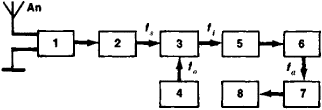superheterodyne receiver
(soo-per-het -ĕ-roh-dÿn) See receiver.superheterodyne receiver
[¦sü·pər′he·trə‚dīn ri′sē·vər]superheterodyne receiver
The common type of AM, FM and TV receiver, which uses intermediate frequency (IF) stages. Rather than demodulating the actual carrier frequency of the transmitting station, which was the approach taken in the early days of radio, "superhet" receivers shift the desired frequency to a single frequency that the receiver can handle very efficiently. The intermediate frequency is then demodulated using direct conversion or homodyne techniques. See IF stage, direct conversion receiver and homodyne receiver.An AM Radio Example
The carrier frequencies for AM operate from 530 kHz to 1610 kHz. Many superheterodyne AM radios use a demodulation circuit designed for 455 kHz. When the listener tunes in a station, an oscillator generates a signal 455 kHz less than the frequency of the desired station. For example, tuning in an 800 kHz station would generate a 345 kHz signal (800-455=345) that would be subtracted from the incoming signal (800-345=455). A bandpass filter then allows only the 455 kHz signal to go to the demodulator circuit to recover the audio. The following FM radio example illustrates this technique.
| Bandshifting to 10.7 MHz IF |
|---|
| In this FM example, the radio is tuned to 101.5 MHz (FM is 88-108 MHz). The intermediate frequency (IF) is 10.7 MHz, and the incoming signals are bandshifted into that frequency, plus and minus 50 kHz for the audio signal and subcarriers. The 1 MHz crystal frequency is an arbitrary reference signal for ensuring the accuracy of the local oscillator. See PLL. |
Superheterodyne Receiver
a radio receiver in which demodulation of an incoming signal is preceded by the conversion (lowering) of the signal’s carrier frequency without the modulation being changed. The superheterodyne receiver is the most common type of radio receiver. It has a comparatively simple and reliable design and provides high-quality signal reception. The superheterodyne circuit was invented in 1918 by E. Armstrong of the USA and L. Lévy of France.

In a superheterodyne receiver with one frequency-conversion stage (Figure 1), an incoming signal with frequency fs passes through an input circuit and radio-frequency amplifier (in some receivers this amplifier is omitted) and enters the mixer of the frequency converter. In the mixer, the radio-frequency signal is combined with oscillations of frequency f0 generated by a local oscillator. The frequency of the resulting signal is known as the intermediate-frequency fi and is equal to the difference between fs and f0. This signal is amplified by an intermediate-frequency amplifier and demodulated. Superheterodyne receivers with more than one frequency-conversion stage are also used.
An important advantage of superheterodyne receivers is that the intermediate-frequency amplifier does not need to be tuned. Regardless of the frequency of the incoming signal, fi can be held constant by adjusting the local-oscillator frequency. For this reason, superheterodyne receivers are easy to tune. Only the input circuit, radio-frequency amplifier, and local oscillator need to be tuned; such tuning is usually carried out by means of a single control knob (seeTRACKING). Since the intermediate-frequency amplifier is not tunable, multicircuit electric filters can be readily used in it to provide high selectivity, and the required signal amplification can be easily obtained. Automatic frequency control and automatic gain control can also be incorporated without difficulty.
A disadvantage of superheterodyne receivers is the possibility of spurious responses due to frequency conversion. For example, an image signal may appear that is separated by 2fi from the frequency to which the receiver is tuned; the image frequency and the frequency of the desired signal exhibit a mirror-like symmetry about fo. Another example of a spurious response is the noise-produced signal distortions that appear as whistles. Methods of minimizing spurious responses include increasing the radio-frequency selectivity of the receiver and choosing an intermediate frequency that is outside the frequency range of the desired incoming signals.
REFERENCES
Radiopriemnye ustroistva. Edited by V. I. Siforov. Moscow, 1974.Chistiakov, N. I., and V. M. Sidorov. Radiopriemnye ustroistva. Moscow, 1974.
V. M. SIDOROV